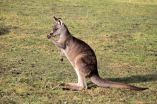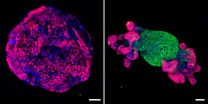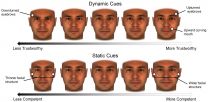Baboon study reveals surprises, breaks ground in tracking behavior
Study was the first to use GPS tracking with a large group of primates
2015-06-18
(Press-News.org) Baboons live in a strongly hierarchical society, but the big guys don't make all the decisions.
A new study from the University of California, Davis, reveals -- through GPS tracking -- that animals living in complex, stratified societies make some decisions democratically. The study breaks ground in how animal behavior data is collected.
The study is being published Friday (June 19) in Science.
"It's not necessarily the biggest alpha males that influence where groups go," said co-author Meg Crofoot, assistant professor of anthropology at UC Davis. "Our results illustrate an important distinction between social status and leadership, and show that democratic decision-making takes place even in highly stratified societies.
"The question we are really trying to tackle with this research is how social animals living in complex societies make decisions. Now we have data about group decision-making in social systems that are complex in many of the ways human societies are complex."
This study was the first to use GPS tracking with a large group of primates. Researchers fitted 25 olive baboons -- nearly the whole troop -- with GPS tracking collars for two weeks. The field work was done in late 2012 at the Mpala Research Center in Kenya.
The GPS units were able to pinpoint within a quarter of a meter the location of each animal at the rate of one location per second resulting in 20 million GPS data points.
"We can closely examine how they are responding to one another," Crofoot said. "These technological advances are giving us unprecedented windows into the lives of group-living of animals."
The technology provided insights never before available.
"Patterns of collective movement in baboons are remarkably similar to models that can predict the movements of fish, birds and insects, which can be predicted using a simple set of rules such as 'follow your neighbor,'" said Damien Farine, co-author of the study and a postdoctoral fellow at UC Davis.
"Decision-making in complex societies may not be all that different than that in animals with more simple societal structures," Crofoot said. "They may all be playing by the same rules."
INFORMATION:
The study was done through The Smithsonian Tropical Research Institute for which Crofoot is a research associate.
Full study at Science:
http://www.sciencemag.org/content/348/6241/1358
Online photos:
http://photos.ucdavis.edu/albums.php?albumId=635856
Video:
https://www.youtube.com/watch?v=O4o2m6o2IK4&feature=youtu.be
ELSE PRESS RELEASES FROM THIS DATE:
2015-06-18
DNA from the 8,500-year-old skeleton of an adult man found in 1996, in Washington, is more closely related to Native American populations than to any other population in the world, according to an international collaborative study conducted by scientists at the University of Copenhagen and the Stanford University School of Medicine.
The finding challenges a 2014 study that concluded, based on anatomical data, that Kennewick Man was more related to indigenous Japanese or Polynesian peoples than to Native Americans. The study is likely to reignite a long-standing legal ...
2015-06-18
NASA provided four different views of Tropical Depression Bill as it continued traveling through the south-central U.S. and into the Ohio Valley. NASA's Aqua and Terra satellite provided infrared and visible imagery while NASA/NOAA's GOES Project animated NOAA's GOES-East satellite imagery to show the storm's progression since landfall. The Global Precipitation Measurement or GPM core satellite also showed rainfall estimates and locations.
On June 18, the National Weather Service, Weather Prediction Center (NWS/WPC) noted that flood and flash flood watches and warnings ...
2015-06-18
Kangaroos prefer to use one of their hands over the other for everyday tasks in much the same way that humans do, with one notable difference: generally speaking, kangaroos are lefties. The finding, reported in the Cell Press journal Current Biology on June 18--the first to consider handedness in wild kangaroos--challenges the notion that "true" handedness among mammals is a feature unique to primates.
"According to a special-assessment scale of handedness adopted for primates, kangaroos pulled down the highest grades," says Yegor Malashichev of Saint Petersburg State ...
2015-06-18
Anti-cancer strategies generally involve killing off tumor cells. However, cancer cells may instead be coaxed to turn back into normal tissue simply by reactivating a single gene, according to a study published June 18th in the journal Cell. Researchers found that restoring normal levels of a human colorectal cancer gene in mice stopped tumor growth and re-established normal intestinal function within only 4 days. Remarkably, tumors were eliminated within 2 weeks, and signs of cancer were prevented months later. The findings provide proof of principle that restoring the ...
2015-06-18
American scientists have discovered that a drug commonly used to treat osteoporosis in humans also stimulates the production of cells that control insulin balance in diabetic mice. While other compounds have been shown to have this effect, the drug (Denosumab) is already FDA approved and could more quickly move to clinical trials as a diabetes treatment. The research is published June 18 in Cell Metabolism.
Diabetes is a major health issue worldwide that arises due to a deficiency of insulin-producing beta cells in the pancreas. In type 1 diabetes, beta cells die from ...
2015-06-18
Cutaneous melanoma, the most deadly form of skin cancer, is now believed to be divided into four distinct genomic subtypes, say researchers at The University of Texas MD Anderson Cancer Center, a finding that could prove valuable in the ever-increasing pursuit of personalized medicine.
As part of The Cancer Genome Atlas, researchers identified four melanoma subtypes: BRAF, RAS, NF1 and Triple-WT, which were defined by presence or absence of mutations from analysis of samples obtained from 331 patients. The five-year study resulted from an international collaboration of ...
2015-06-18
PHILADELPHIA -- Most of us need seven to eight hours of sleep a night to function well, but some people seem to need a lot less sleep. The difference is largely due to genetic variability. In research published online June 18th in Current Biology, researchers report that two genes, originally known for their regulation of cell division, are required for normal slumber in fly models of sleep: taranis and Cyclin-dependent kinase 1 (Cdk1).
'There's a lot we don't understand about sleep, especially when it comes to the protein machinery that initiates the process on the ...
2015-06-18
In 2012, researchers at the Stanford University School of Medicine showed that heart muscle cells made from the skin of people with a cardiac condition called dilated cardiomyopathy beat with less force than those made from the skin of healthy people. These cells also responded less readily to the waves of calcium that control the timing and strength of each contraction.
Now, the same research team has teased apart the molecular basis for these differences and identified a drug treatment that at least partially restores function to diseased cells grown in a laboratory ...
2015-06-18
Adult neural stem cells, which are commonly thought of as having the ability to develop into many type of brain cells, are in reality pre-programmed before birth to make very specific types of neurons, at least in mice, according to a study led by UC San Francisco researchers.
"This work fundamentally changes the way we think about stem cells," said principal investigator Arturo Alvarez-Buylla, UCSF professor of neurological surgery, Heather and Melanie Muss Endowed Chair and a principal investigator in the UCSF Brain Tumor Research Center and the Eli and Edythe Broad ...
2015-06-18
We can alter our facial features in ways that make us look more trustworthy, but don't have the same ability to appear more competent, a team of New York University psychology researchers has found.
The study, which appears in the Personality and Social Psychology Bulletin, a SAGE journal, points to both the limits and potential we have in visually representing ourselves--from dating and career-networking sites to social media posts.
"Our findings show that facial cues conveying trustworthiness are malleable while facial cues conveying competence and ability are significantly ...
LAST 30 PRESS RELEASES:
[Press-News.org] Baboon study reveals surprises, breaks ground in tracking behavior
Study was the first to use GPS tracking with a large group of primates



